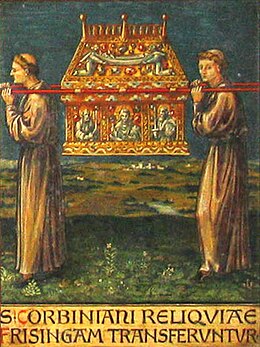
Back Translace (náboženství) Czech Reliquientranslation German Traslación (reliquia) Spanish Translation (reliques) French Translasi relikui ID Translatiefeest Dutch Translasjon i religion NN Translasjon (kristendom) NB Translacja (kult świętych) Polish Translação (relíquia) Portuguese

In Christianity, the translation of relics is the ceremonial removal of holy objects from one place to another (usually a higher-status location). Usually only the movement of the remains of a saint's body would be treated so formally, with secondary relics such as items of clothing treated with less ceremony. Translations could be accompanied by many acts, including all-night vigils and processions, often involving entire communities.
The solemn translation (in Latin, translatio) of relics is not treated as the outward recognition of sanctity. Rather, miracles confirmed a saint's sanctity, as evinced by the fact that when, in the twelfth century, the papacy attempted to make canonization an official process; many collections of miracles were written in the hope of providing proof of the saint-in-question's status. In the early Middle Ages, the solemn translation marked the moment at which, the saint's miracles having been recognized, the relic was moved by a bishop or abbot to a prominent position within the church. Local veneration was then permitted. This process is known as local canonization.[1]
The date of a translation of a saint's relics was often celebrated as a feast day in its own right. For example, on January 27 is celebrated the translation of the relics of St. John Chrysostom from the Armenian village of Comana (where he died in exile in 407) to Constantinople.[2] The most commonly celebrated feast days are the dies natales (the day on which the saint died, not the modern idea of birthday).
Relics sometimes travelled very far. The relics of Saint Thyrsus at Sozopolis, Pisidia, in Asia Minor, were brought to Constantinople and then to Spain. His cult became popular in the Iberian Peninsula, where he is known as San Tirso or Santo Tirso.[3] Some of his relics were brought to France: Thyrsus is thus the titular saint of the cathedral of Sisteron in the Basses Alpes,[4] the Cathédrale Notre Dame et Saint Thyrse. Thyrsus is thus the patron saint of Sisteron.[5] Liborius of Le Mans became patron saint of Paderborn, in Germany, after his relics were transferred there in 836.[6]
- ^ Eric Waldram Kemp, Canonization and Authority in the Western Church, Oxford, 1948.
- ^ "The Translation of the Relics of St. John Chrysostom". www.fatheralexander.org.
- ^ Christian Iconography Archived 2006-09-09 at the Wayback Machine
- ^ "Saint of the Day | Saint Thomas Aquinas, Doctor (Memorial) January 28". Archived from the original on 2014-08-07. Retrieved 2012-02-22.
- ^ "Cathédrale Notre-Dame et Saint-Thyrse". www.sisteron-buech.fr.
- ^ "Saints of July 23".